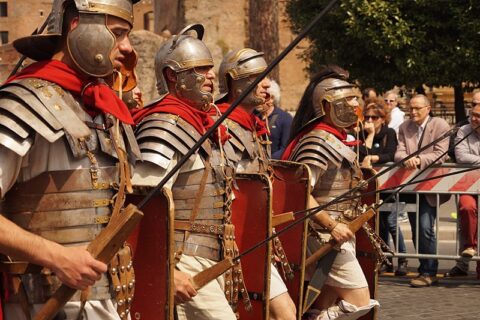World War Two
Published 14 Feb 2024The modern artillery of the Great War was responsible for the vast majority of military deaths in that conflict, but how has artillery developed from that war to this one? Today we take a look at some of the artillery of WW2.
(more…)
February 15, 2024
Artillery! A WW2 Special
Tune in for the propaganda, stay tuned for the epic meltdowns
Are you old enough to remember when “news” in the legacy media was, well, calmly presented factoids (accurate or not) that might get you upset, but the emotional content wasn’t heightened or enacted by the hairspray heads in front of the camera? Those days are long enough past that they might never have happened, as Chris Bray illustrates:
Spend a minute of your life looking at a chart that shows how much countries spend on their militaries as a percentage of GDP. The US spends about 3.5%, while Germany spends about 1.4%. For years, hawks have argued that the US should spend 4% of GDP on defense, in a well-known debate about reasonable funding for security. NATO members commit to a target of 2% or better, and many don’t make that goal. Donald Trump says he told the leaders of NATO countries that they should make or beat their military spending targets to ensure their own security, and as a negotiating ploy he poked at them and said that he wouldn’t bother to defend people who wouldn’t bother to pay for their own defense.
You can agree with his argument or disagree with his argument, and make whatever argument you want about the carefulness or recklessness of Trump’s rhetorical style, but none of this is obscure.
And so now we’re living through an ORANGE MAN LITERALLY HITLER CRISIS, as Orange Satan Drumpf tells the Putin Devil to absolutely MURDER all the Europeans and the world teeters in agony at the very brink of a harvest of slaughter. Here, let Forbes just give you the news, straight and factual and to-the-point:
THE MEAN MAN SAYING FOR THE PUTIN DEVIL TO MURDER ALL THE LITTLE BABIES professional journalists calmly explain, absolutely biting through the rubber nipple on their pacifiers. Sackcloth, ashes, endlessly refillable SSRI prescription: journalist starter kit.
In the car a few minutes ago, I turned on the radio mid-interview to hear a hysterical NPR anchor begging a European pundit to agree that Trump is a vicious monster, and the European — I missed his name — sighed and said that look, this is a debate that we’ve been having for a while, it’s a pretty normal discussion. BUT DON’T YOU THINK HE’S AN ORANGE MURDER DEVIL!?!?!? Then they played an important clip of Slow Joe Biden slurring and fake-shouting about Trump’s un-American cruelty, sounding almost as angry as he was when he talked about how many actual chips they put in the potato chip bags. This is why I listen to NPR in short bursts, like a gun run from an A-10. Brrrrrrrrrt, and off.
But what’s inescapable about this extremely dull moment, yet again, is that an allegedly elite layer of political, academic, and media figures are taking something routine and willfully inflating it into a five-alarm global crisis. It … must be a day ending in -y? Nothing is ever bad, or disagreeable, or arguable; every event is The Absolute Worst. Every development must be discussed in hyperemotional terms; every objectionable act is devastating, terrifying, destructive, ruinous, treasonous, unforgivable. No one disagrees with us; rather, they are ENEMIES OF EVERYTHING WE STAND FOR!!!!!
The Big Picture – NATO: Partners in Peace (1954)
Army University Press
Published Nov 13, 2023NATO: Partners in Peace follows the creation and impact of the North Atlantic Treaty Organization (NATO). Created in April 1949 with twelve founding members, this organization’s goal was to protect the inherent rights of individual states through collective defense. In this episode from The Big Picture series, General Dwight D. Eisenhower offers a speech before he deploys to Europe to become the first Supreme Allied Commander Europe (SACEUR). This is followed with footage of the buildup and training of European forces. Once Eisenhower leaves NATO to campaign for the presidency, General Matthew Ridgway replaces him as NATO commander. One significant problem NATO forces faced was the fact that each nation had its own weapon systems and ammunition, an issue the U.S. wanted to address with the standardization of the 7.62mm cartridge. Perhaps as a deterrent to the Soviet Union, NATO: Partners in Peace depicts new weapons that could be used against a large enemy force such as remote-controlled missiles, napalm bombs, and the massive atomic cannon.
QotD: Multitasking is a myth
Now I have begun referring to myself as a slasher, I thought I should probably check that my potential hirers in the fantasy world of secure employment – the great unslashed, as it were – correctly understand what the word means. So I went a-Duck-Duck-Going and found this definition:
Slasher: Someone who works in multitask mode
Oh no, I don’t like that. Multitasking is a myth. Multitasking means simultaneously doing lots of things equally badly. A Jack of all failures? No thanks. Let’s see if there’s an alternative description …
Slashers come from all walks of life, and are also referred to as “hustlers”/”work-a-holics”. They are prone to work endlessly in pursuit of accomplishing their goals because of their thirst and hunger for success &/or personal fulfilment.
Almost right: the thirst and hunger come from not being paid on time. This can leave a slasher feeling poor SLASH homeless.
Alistair Dabbs, “Multitasking is a myth: It means doing lots of things equally badlySome people just like to take the p*ss”, The Register, 2019-09-27.
February 14, 2024
The ARRIVESCAM scandal will probably not matter politically for Trudeau
If there’s one thing we should have learned about Justin Trudeau, it’s that he’s got world class Teflon coating when it comes to any kind of scandal that would destroy other politicians. Despite the auditor-general’s scathing report, it’s very likely that Trudeau’s remaining popularity won’t take any measurable hit:
It is into this context that we insert Karen Hogan’s Monday report on the government’s ArriveCan app.
Hogan looked into the government’s troubled COVID-19 ArriveCan app and found nothing.
Actually nothing. The auditor’s exact words: “The Canada Border Services Agency’s documentation, financial records, and controls were so poor that we were unable to determine the precise cost of the ArriveCAN application.” That means the accountant whose job it is to tell taxpayers what the government is spending money on, could not complete her task. Why?
Well, she also said, “That paper trail should have existed … Overall, this audit shows a glaring disregard for basic management and contracting practices.” The auditor general could not tell taxpayers what the app cost, who decided who got paid, who did the work and what the money was ultimately spent on.
Mob contracts have more detail than the auditor general was able to piece together for her ArriveCan report. But, then again, mobsters keep two books.
The Canadian Border Services Agency appears to have burned, lost or had several goats eat pertinent records that pertain to Canadian taxpayers spending tens of millions of dollars on a phone app that never worked, kept no one safe, and has mostly come to symbolize an Ottawa where no one really feels accountable to anyone.
As someone who regularly sat down with the civil service to discuss transfer payment agreements a fraction of the size of the almost $60 million — or more, who knows?! — that is speculated to have been spent on ArriveCan, this fails to pass any kind of credibility test. ArriveCan was a priority government initiative in 2020 and 2021. We were trying to get the border back open. The tourism sector was on the brink. The idea that this was a couple rogue CBSA agents who were just funnelling taxpayer dollars to a firm with whom they had connections is a convenient, but drastically incomplete, telling of the story.
Tens of millions of dollars disappearing in a matter of weeks-to-months, and no one in the civil service asked a question? No one in the minister’s office got a briefing on the app’s progress? There isn’t a single PowerPoint deck anywhere in the government? The civil service — especially the federal civil service — issues CYA memos to cover bathroom breaks but no one had any earthly idea what tens of millions of dollars going out the door on a priority government initiative were being spent on?
It is to laugh.
“… one of the most contemptible pieces of legislation since the introduction of the Indian Act in 1876″
In the National Post, Stephen Buffalo explains why many Canadian First Nations people are angry with NDP MP Charlie Angus for his recently introduced Private Member’s Bill in Parliament:

“Charlie Angus at convention 2023 2 (cropped)” by DrOwl19 is licensed under CC BY-SA 4.0 .
First Nations people used to consider NDP MP Charlie Angus an ally, as he has been outspoken on issues of Indigenous poverty and government mismanagement. Canadians do not want to know what many Indigenous people are calling him these days.
Last week, Angus tabled a private member’s bill, C-372, that is one of the most contemptible pieces of legislation since the introduction of the Indian Act in 1876. Angus’ proposed fossil fuel advertising act would outlaw oil and gas advertising and the “promotion” of fossil fuels, even by some private citizens. If passed, this would be the most egregious attack on civil liberties in recent Canadian history.
It is astonishing that an experienced parliamentarian like Angus could bring such nonsense forward. All Canadians, of all political stripes, should be outraged at this attempt to stifle public discussion.
Through actions like this, Angus and his environmental supporters — like the Sierra Club, Suzuki Foundation, Earthjustice, Greenpeace, 350.org and others — have shown themselves to be no fans of Indigenous peoples. These single-minded environmentalist organizations ignore the interests of First Nations, Metis and Inuit communities, except when they want to impose their will on them.
Angus has thrown his lot in with the wrong people. They are happy to tell us what to do on energy and environmental matters. But they are never around to fix our water issues, health-care problems, housing crises and rampant drug challenges. They clearly want Indigenous people to stay silent and follow their lead. No wonder many Indigenous folk describe environmentalists as the “new missionaries”.
While some of our members share the views of Angus and his ilk, most First Nations people support carefully managed resource and infrastructure development. We need our own resource revenue to break free from our dependence on government and to chart our own futures. Indigenous communities finally have prosperity and independence in sight.
People like Charlie Angus may agonize over our hardships, but they are content to maintain the Indian Act-style paternalism that created so much of the pain we endure. They must back off. First Nations, Metis and Inuit folk will not accept being shut up and will not tolerate people trying to tell us how to use our land and our resources.
Soviet World War Two Swords? The M1927 Shashka
Cossack forces have long been a key cavalry element of the Russian military, and this did not change during the Soviet era. The Cossacks had their own rather distinctive style of sword, the shashka, and the Red Army maintained the tradition of issuing them to Cossack cavalry troopers. In 1927, a new pattern was adopted, and it was produced and issued from 1928 until 1946. The shashka has a slightly curved, single-edged blade and no handguard. The model 1927 military type was initially made with a rather decorative pommel, but this was simplified to just a plain 5-pointed star as German advances into Russia really stressed Soviet industrial production. However, production and issue of the shashka continued uninterrupted throughout the war.
Originally there were separate trooper and officer versions of the model 1927, with the trooper version including the ability to stow the trooper’s Mosin-Nagant rifle bayonet on the side of the shaskha scabbard. As cavalry, the Cossacks were not expected to carry their rifles with bayonets fixed, and this served in lieu of a bayonet sheath. By 1944 this feature was omitted, as the M91/30 was replaced by the M38 and M44 carbines and submachine guns, which did not use bayonets.
The decorations returned to the M1927 shashka in 1945, with a series made for the Victory Day parade celebrating the defeat of Germany. Today’s example is one of these, and in beautiful condition.
QotD: Judging historical figures’ actions
It is important to judge people and events in their own time. First, because that’s the only way we really can judge them.
You can’t judge people on actions they didn’t know were wrong, or on things that were hidden from them, which only time has revealed. Or rather, you can, but it’s deranged. What you are holding people guilty of is not being psychic. Not being able to foretell the future. Well, none of us can. Not with any accuracy, and never about things we want to. (Yeah, sometimes I get something like glimpses, but seriously? Do you see me among the lottery winners? No? That’s because I can’t see the future in a significant way.) Go ahead and despise people for that failing, but be aware you’re being deranged.
Also, unlike the people on the left, most of us are aware we, ourselves, are not infallible, and our time is not the pinnacle of knowledge and morality. Things that seem right to us now — or at least not markedly wrong — can and will be reviled by future lovers of liberty.
Sarah Hoyt, “In Their Time”, According to Hoyt, 2023-11-07.
February 13, 2024
“I am a proud member of the Airfix generation”
I didn’t realize that Peter Caddick-Adams is the same age as me, but it does seem that our interests pretty much ran parallel for a while:

Re-enactors in Roman legionary gear, 19 May, 2021.
Original photo from https://pxhere.com/en/photo/883133 via Wikimedia Commons.
I am a proud member of the Airfix generation. The desire (less so the ability) to assemble and paint plastic model kits of aircraft, tanks and ships hit me squarely between the eyes on my tenth birthday in 1970. Several aunts and uncles had arrived at the same solution to bring out my inner Spitfire on the same day. Who needed the high of polystyrene cement and Humbrol enamel when you could refight D-Day across your bedroom floor with kits costing as little as 1/6d? Although Airfix was the premium producer of scale kits, other competing brands included Frog, Tamiya, Monogram, Hasegawa and Revell. I wish I knew what I did with them all, but many of the aircraft I recall casting out of upstairs windows, set on fire by match and candle. Looking back, I can see how it sewed the seeds of my becoming a professional military historian decades later. From little acorns, eh?
Two years later, I discovered I was interested in anything historical when my parents packed us into a train (great excitement in itself) for a trip to London. Although long past the days of steam, I can remember my father walking me down to thank the engine driver for getting us safely into Euston and then the true adventure began. The arrival at the British Museum to see the Tutankhamun Exhibition, which ran from March to December 1972. When it ended, besides the young Caddick-Adams, 1.6 million visitors had passed through the exhibition doors, making it the most popular attraction in the museum’s history. My favourite art class activity thereafter altered from drawing Spitfires and Messerschmitts chasing each other across every page to depicting ghostly, golden burial masks. Ever since, I have held an unbelievably soft spot for the old BM, always remembering that due to its vastness, it is best to go there to see something specific, rather than wander hither and thither, lost in its many treasures.
Then in 1977, when studying Ancient History for “A” Level, it was the turn of the Royal Academy in Piccadilly to capture my imagination with its Pompeii AD 79 exhibition. Mosaics, personal possessions, wall paintings and plaster casts of Romans and their animals caught in the moment of death as toxic gases, ashes, molten rock and pulverized pumice froze them forever, like insects in amber, likewise left a profound mark on my understanding of the bigger wheels of history.
The other day I was more than happy to be reunited with my old friend, the British Museum, this time hosting another Roman exhibition, which promises to be every bit as impactful as the Tutankhamun and Pompeii antecedents. Just unveiled, Legion: Life in the Roman Army is an inspired portrayal of an institution which numbered around 450,000 at its peak in AD 211 (33 legions and c. 400 auxiliary regiments), although numbers always fluctuated. The first amazing realisation is how little archaeological evidence remains of this vast organisation that endured for many centuries. The second is how well the scanty remnants in this exhibition have been preserved and interpreted.
Here, the British Museum has assembled the best surviving examples of arms, armour and personal possessions from collections around the world, in over 200 artefacts from 28 lenders. Though we view gleaming bronze helmets, swords long-rusted into scabbards, a pile of near-fossilised chainmail, it is incredible to think that there is only one intact example remaining of all those hundreds of thousands of rectangular and curved legionary shields (called a scutum), still bearing its decoration and crimson dye. This one comes from Syria.
There are some fine funerary carvings of Roman officers from around the empire, then we encounter some of the battlefield detritus including breastplate armour found near Kalkriese, in the Teutoburgerwald of Lower Saxony. This is where a coalition of Germanic tribes led by a rebel chieftain called Arminius ambushed 3 legions led by Publius Quinctilius Varus in 9 AD. The story of discovering this battle terrain was as dramatic as the assault itself. It was the result of a meticulous British soldier who combed an area north of his base at Osnabrück with a metal detector in 1987. Major Tony Clunn recorded each discovery of Roman coins and sling shot, making it possible to reconstruct the route taken by Roman legionaries under Varus and determine where they were ambushed and massacred.
Greek History and Civilisation, Part 2 – Sparta and Athens: Contrasting Societies
seangabb
Published Feb 11, 2024This second lecture in the course contrasts Athens and Sparta, the two leading societies in Greece — one a commercial society with high levels of personal freedom and citizen participation, the other a militarised oligarchy.
[NR: Some additional information to supplement Dr. Gabb’s lecture:
– “Citizenship” in the ancient and clasical world
– Sparta had Lycurgus, while Athens had Solon … who at least actually existed
– The Constitution of Athens
– The Constitution of the Spartans
– The Myth of Spartan Equality
– Relative wealth among the Spartiates
– Sparta’s military reputation as “the best warriors in all of Greece”
– Sparta – the North Korea of the Classical era
– Spartan glossary]
(more…)
Step aside, puny humans, here comes “the new Marxist Homo tabularasa“
At Postcards from Barsoom, John Carter considers what might occupy the god-shaped space in the new secular religion of wokeness:

Ryan T. Hancock, via Postcards from Barsoom
It’s trite to observe that the Great Awokening is a fundamentally religious phenomenon, representing a sort of secular Abrahamic heresy mining the latent guilt swirling within the hearts of post-Christian whites and thereby activating the messiah complexes of the Anglosphere’s Protestant populations, who have exhibited other similarly self-destructive enthusiasms throughout their ethnoreligious histories. It’s trite because it’s so obviously apt, but it raises an obvious question: if Woke is a cult, what is its god?
I don’t mean whichever symbols or causes they flock to from one moment to the next. These are merely mortal embodiments of archetypal forms, rising perhaps to the level of heroes or saints should their celebration become widespread enough. George Floyd was not deified but beatified, not because of anything he did in his life (which no one really argues wasn’t a sewer of petty criminality), but because in his death he was filled with a holy spirit of some kind. What spirit was that?
One answer to this question is provided in the title of Lorenzo Warby‘s ongoing series “Worshipping the Future“. As Warby explains in “The Deep Appeal of Marxism“, progressivism is besotted with the transformational future, an imaginary utopia qualitatively different from and superior to the Tartarus of antiquity in every way – an Elysium of peace, stability, equality, wealth, ease, comfort, and bliss, existing in a perpetual state of liberatory ecstasy in which the war, chaos, poverty, strife, suffering, and misery of the past have been permanently eradicated.
As Warby writes, there is no limit to the delights of the transformational future:
As a thing imagined, it can be imagined to be as perfect as one likes. This means politics grounded in an imagined future can be as morally grandiose as one likes, with whatever moral urgency goes with such imaginings.
This is deeply intoxicating.
Grounding one’s politics in an imagined future also provides huge rhetorical advantages, precisely because said future is as perfect as one wants it to be. Anyone who wishes to defend some actually existing thing has the problem that it will be the product of trade-offs and human failings.
An “imagined future” believer, by contrast, can just wish all that away for political purposes while hanging current imperfections on those who wish to defend what exists. In any contest between the actual and the imagined, the imagined sparkles ever so more brightly.
This utopia is of course always at some point just over the horizon. Just one more revolution, bro, and we’ll reach the Promised Land! Just one more gulag, and we’ll get to utopia, I swear! C’mon bro, just one more mass grave, we’re almost there, you gotta believe me!
There is a fatal epistemic flaw at the heart of this faith: no information can be extracted from the future, because information can only be obtained from the past.
Not only does the imagined future have no reality test, it distorts one’s use of the information to which we do have access. The past is profoundly discounted by its distance and difference from the imagined future. It is both morally discounted — a record of sin and depravity — and structurally discounted, because it has not undergone the social transformations that are imagined to change everything.
If the imagined future is a secular heaven, then the past becomes a moral hell from which we must escape. All information from it is tainted as profoundly impure and corrupt: the record of sin.
This means that when policies fail to obtain the desired result, for example erasing ethnic and sexual distinctions through affirmative action and thereby producing the new Marxist Homo tabularasa, no corrective action is possible. Policy failure exists in the past, which is ignored as sinful, and which therefore cannot be learned from. The only permissible answer to failed progress is to progress faster, with the only possible consequence being to fail harder.
GO Transit – North America’s BEST Commuter Rail Network
Lonestar Trip Reports
Published Nov 11, 2023Hello and Welcome to Oshawa, Ontario! Today we’re riding with GO Transit, Toronto’s commuter rail provider, from here down to Toronto Union Station.
Trip Information
Train Number: GO Lakeshore East 9015
Locomotive: MPI MP36PH-3C 609
Departure Time: 10:10am
Arrival Time: 11:11am
Journey Time: 1hr 1min
Price: $10.00Thanks for watching and I hope you enjoyed!
QotD: War elephant logistics
From trunk to tail, elephants are a logistics nightmare.
And that begins almost literally at birth. For areas where elephants are native, nature (combined, typically, with the local human terrain) create a local “supply”. In India this meant the elephant forests of North/North-Eastern India; the range of the North African elephant (Loxodonta africana pharaohensis, the most likely source of Ptolemaic and Carthaginian war elephants) is not known. Thus for many elephant-wielding powers, trade was going to always be a key source for the animals – either trade with far away kingdoms (the Seleucids traded with the Mauyran Indian kingdom for their superior Asian elephants) or with thinly ruled peripheral peoples who lived in the forests the elephants were native to.
(We’re about to get into some of the specifics of elephant biology. If you are curious on this topic, I am relying heavily on R. Sukumar, The Asian Elephant: Ecology and Management (1989). I’ve found that information on Asian elephants (Elephas maximus) much easier to come by than information on African elephants (Loxodonta africana and Loxodonta cyclotis).)
In that light, creating a breeding program – as was done with horses – seems like a great idea. Except there is one major problem: a horse requires about four years to reach maturity, a mare gestates a foal in eleven months and can go into heat almost immediately thereafter. By contrast, elephants reach adulthood after seventeen years, take 18-22 months to gestate and female elephants do not typically mate until their calf is weaned, four to five years after its birth. A ruler looking to build a stable of cavalry horses thus may start small and grow rapidly; a ruler looking to build a corps of war elephants is looking at a very slow process. This is compounded by the fact that elephants are notoriously difficult to breed in captivity. There is some speculation that the Seleucids nonetheless attempted this at Apamea, where they based their elephants – in any event, they seem to have remained dependent on imported Indian elephants to maintain the elephant corps. If a self-sustaining elephant breeding program for war elephants was ever created, we do not know about it.
To make matters worse, elephants require massive amounts of food and water. In video-games, this is often represented through a high elephant “upkeep” cost – but this often falls well short of the reality of keeping these animals for war. Let’s take Total War: Rome II as an example: a unit of Roman (auxiliary) African elephants (12 animals), costs 180 upkeep, compared to 90 to 110 upkeep for 80 horses of auxiliary cavalry (there are quite a few types) – so one elephant (with a mahout) costs 15 upkeep against around 1.25 for a horse and rider (a 12:1 ratio). Paradox’s Imperator does something similar, with a single unit of war elephants requiring 1.08 upkeep, compared to just 0.32 for light cavalry; along with this, elephants have a heavy “supply weight” – twice that of an equivalent number of cavalry (so something like a 2:1 or 3:1 ratio of cost).
Believe it or not, this understates just how hungry – and expensive – elephants are. The standard barley ration for a Roman horse was 7kg of barley per day (7 Attic medimnoi per month; Plb. 6.39.12); this would be supplemented by grazing. Estimates for the food requirements of elephants vary widely (in part, it is hard to measure the dietary needs of grazing animals), but elephants require in excess of 1.5% of their body-weight in food per day. Estimates for the dietary requirements of the Asian elephant can range from 135 to 300kg per day in a mix of grazing and fodder – and remember, the preference in war elephants is for large, mature adult males, meaning that most war elephants will be towards the top of this range. Accounting for some grazing (probably significantly less than half of dietary needs) a large adult male elephant is thus likely to need something like 15 to 30 times the food to sustain itself as a stable-fed horse.
In peacetime, these elephants have to be fed and maintained, but on campaign the difficulty of supplying these elephants on the march is layered on top of that. We’ve discussed elsewhere the difficulty in supplying an army with food, but large groups of elephants magnify this problem immensely. The 54 elephants the Seleucids brought to Magnesia might have consumed as much food as 1,000 cavalrymen (that’s a rider, a horse and a servant to tend that horse and its rider).
But that still understates the cost intensity of elephants. Bringing a horse to battle in the ancient world required the horse, a rider and typically a servant (this is neatly implied by the more generous rations to cavalrymen, who would be expected to have a servant to be the horse’s groom, unlike the poorer infantry, see Plb. above). But getting a war elephant to battle was a team effort. Trautmann (2015) notes that elephant stables required riders, drivers, guards, trainers, cooks, feeders, guards, attendants, doctors and specialist foot-chainers (along with specialist hunters to capture the elephants in the first place!). Many of these men were highly trained specialists and thus had to be quite well paid.
Now – and this is important – pre-modern states are not building their militaries from the ground up. What they have is a package of legacy systems. In Rome’s case, the defeat of Carthage in the Second Punic War resulted in Rome having North African allies who already had elephants. Rome could accept those elephant allied troops, or say “no” and probably get nothing to replace them. In that case – if the choice is between “elephants or nothing” – then you take the elephants. What is telling is that – as Rome was able to exert more control over how these regions were exploited – the elephants vanished, presumably as the Romans dismantled or neglected the systems for capturing and training them (which they now controlled directly).
That resolves part of our puzzle: why did the Romans use elephants in the second and early first centuries B.C.? Because they had allies whose own military systems involved elephants. But that leaves the second part of the puzzle – Rome doesn’t simply fail to build an elephant program. Rome absorbs an elephant program and then lets it die. Why?
For states with scarce resources – and all states have scarce resources – using elephants meant not directing those resources (food, money, personnel, time and administrative capacity) for something else. If the elephant had no other value (we’ll look at one other use next week), then developing elephants becomes a simple, if difficult, calculation: are the elephants more likely to win the battle for me than the equivalent resources spent on something else, like cavalry. As we’ve seen above, that boils down to comparisons between having just dozens of elephants or potentially hundreds or thousands of cavalry.
The Romans obviously made the bet that investing in cavalry or infantry was a better use of time, money and resources than investing in elephants, because they thought elephants were unlikely to win battles. Given Rome’s subsequent spectacular battlefield success, it is hard to avoid the conclusion they were right, at least in the Mediterranean context.
Bret Devereaux, “Collections: War Elephants, Part II: Elephants against Wolves”, A Collection of Unmitigated Pedantry, 2019-08-02.
February 12, 2024
A mustard lover’s journey
Every week, Substack helpfully sends along a collection of new-to-me Substacks to entice me to subscribe to yet another — in Substack’s ideal world, I’d be a paid subscriber to many, but I don’t live in that world, I’m afraid. Saturday’s mailing included Chloe List’s paean to the condiment mustard, in all its many guises:
A Mustard Deep Dive
I have so many feelings about mustard I don’t even know where to start. It’s my favorite color (marigold, mustard yellow, same difference). I’m from Chicago. I love hot dogs. If you don’t understand, google “chicago ketchup”. I blow through jars of dijon like it’s nobody’s business because can you even make a good salad dressing without it? Just last week, I went to a German restaurant and ordered a plate-sized chicken schnitzel that was more or less a vessel for eating their incredible mustards (one sweet, one spicy). All to say, it’s a perfect condiment and it doesn’t get the love and respect it deserves. And let me tell you, the Mustard Rabbit Hole did not disappoint. The packaging is so inspiring and sincere, and I’m this close to booking a flight to Europe so I can buy some mustard in a tube (more on that below). Anyways, please enjoy this deep dive into a product category that is seemingly untouched by trendy packaging design in the best way. But first …
1. Mustard for the person who has the palate of a 277-year-old
Grey Poupon was founded in 1866. Colman’s was founded in 1814. Maille was founded in 1747! I didn’t know just how old these legacy brands were until I started researching this letter, but after digging further it’s not all that surprising. Mustard as a spice is one of the earliest on record, appearing in Sanskrit manuscripts around 3000 BCE, and mustard as a condiment dates back to the early Romans. I’d love to see how they were storing this colorful condiment back then, but I’m quite pleased with how these brands are jarring it today. Per usual, this is one of my favorite categories in this deep dive because of that whole “timeless cool” thing that always wins for me when it comes to packaging design. Side note, I’m now obsessed with vintage mustard pots.
2. Mustard for the person who longs for the days of “Harvest Gold”
What’s “harvest gold”, you may be asking? Picture the “before” photo of a fixer-upper kitchen remodel in Domino. Or any number of recent brands that have been bringing back that avocado green and orange/yellow palette. All to say, these bottles and jars look like they could be set pieces on The Brady Bunch or That ’70s Show. And because apparently mustard brands can do no wrong, these are all working. They don’t feel try-hard or overly designed, but rather truly feel like they time traveled 50 years to the future. I especially love that top left bottle of Finnish mustard and the type on Mister Mustard. Also, Mustard Girl would be a great Halloween costume.
Yalta, When Stalin Split the World – a WW2 Special
World War Two
Published 11 February 2024Indy and Sparty take you through the negotiations at Yalta as The Big Three thrash out the shape of the postwar world. As the splits between East and West continue to deepen, who will come out on top?
(more…)







